Dumbbell Tripod Rear Delt Raise
How to Do the Bent Over Bench Rear Delt Raise w/ Dumbbell | In-Depth Guide [VISUAL LEARNERS] Beginner
Proper Form & Common Mistakes | Home Resistance Training
WHAT DO YOU WANT TO SEE?
QUICK DEMO
QUICK DEMO
MUSCLES THIS WORKS
MUSCLES
MAIN MUSCLES WORKED IN Dumbbell Tripod Rear Delt Rows
Rear Deltoid
The rear delt (aka posterior delt) is the back of your main shoulder muscle, called the deltoid.
OTHER MUSCLES WORKED:
- All portions of the deltoid muscle; scapular muscles (pectoralis minor, subclavius, latissimus dorsi, lower trap, serratus)
- External rotators ( infraspinatus and teres minor).
STARTING POINTERS
Starting Pointers
WHAT WE'RE DOING TODAY
ALL WE'RE DOING:
Bent Over On a Bench, We'll Pull One Arm Up Towards the Ceiling.
This bench rear delt raise variation is a nice position to use if you have difficulty keeping your upper body still while doing the bent-over rear deltoid rows. This is an effective shoulder exercise that can be done with dumbbells. The extra support of the tripod position may allow you to use a heavier weight and still have good form. When working only one arm at a time, the muscles of the obliques and quadratus lumborum will be a little more active to prevent any spinal rotation or side bending.
HOW TO DO THE EXERCISE
LOOKS
HOW Dumbbell Tripod Rear Delt Rows SHAPE OUR BODY
Toned, balanced, capped shoulders, good posture.
PROPER FORM
PROPER FORM: Dumbbell Bent over Rear Delt Row
EQUIPMENT, SETS & REPS
EQUIPMENT
Bench, chair, stool or low table.
SUGGESTED STARTING WEIGHT FOR WOMEN:
5-8 lbs
SETS & REPS:
2 sets of 8 reps
PACE:
Moderate up and slower down.
BODY POSITION
BODY POSITION FOR THE Dumbbell Tripod Rear Delt Raise
Stand close to the end of a bench, chair, or coffee table.
FEET: Toes forward. Feet parallel and a comfortable distance apart. A wider (slightly wider than hip width) can help stabilize and maintain a neutral position during the movement.
BODY STANCE: Knees slightly bent. HInge forward at the hips and place the non working hand on the bench. Spine neutral, sternum lifted, chest broad. Torso level with shoulders and hips squared.
ARMS: Nonworking hand is on the bench, directly under your shoulder (hand is not in front of, or behind, your shoulder. Elbow is not locked. Working arm: When bent over, your arm is hanging straight down to the floor (the hand will rest in line with the shoulder joint).
HAND/GRIP: Neutral or pronated grip, whatever is comfortable and feels natural.
NECK: Relaxed, neutral, space between top of your shoulder and earlobe.
HOW TO DO
HOW TO DO Dumbbell Tripod Rear Delt Rows
CUE: Think of leading with your elbow as your arm moves upwards (towards behind the body).
Pull your shoulder blade back and down as you lift your working arm up (backwards relative to the torso).
Let your elbow bend as your upper arm moves behind your body. Your upper arm should be angled away from your body, so that your elbow lifts back and away from your torso.
Lift your forearm to rotate your upper arm backwards (so the hands come upward towards the “don’t shoot” position).
Your upper arm should be lifted back, your upper arm about 60 -80°away from the side of your body with your elbow bent 70- 90° at the end of the movement. This should be fluid - shoulder pulling your arm back and rotating it.
Pause at the end of the movement, slowly return to the starting position and repeat.
HOW TO SAFELY GET OUT OF THE EXERCISE
Take your arm off of the bench, squat down and set weight on the floor.
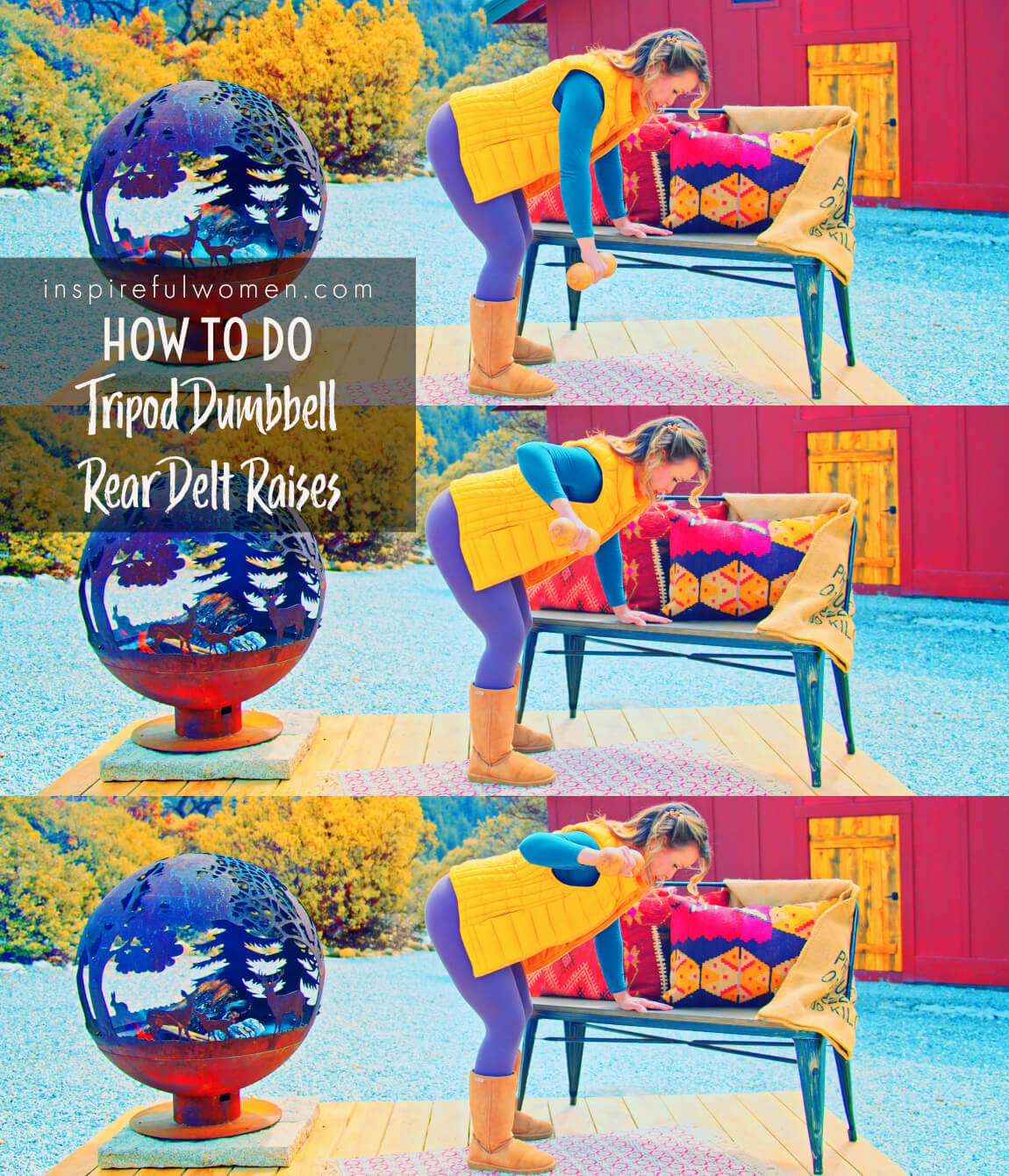
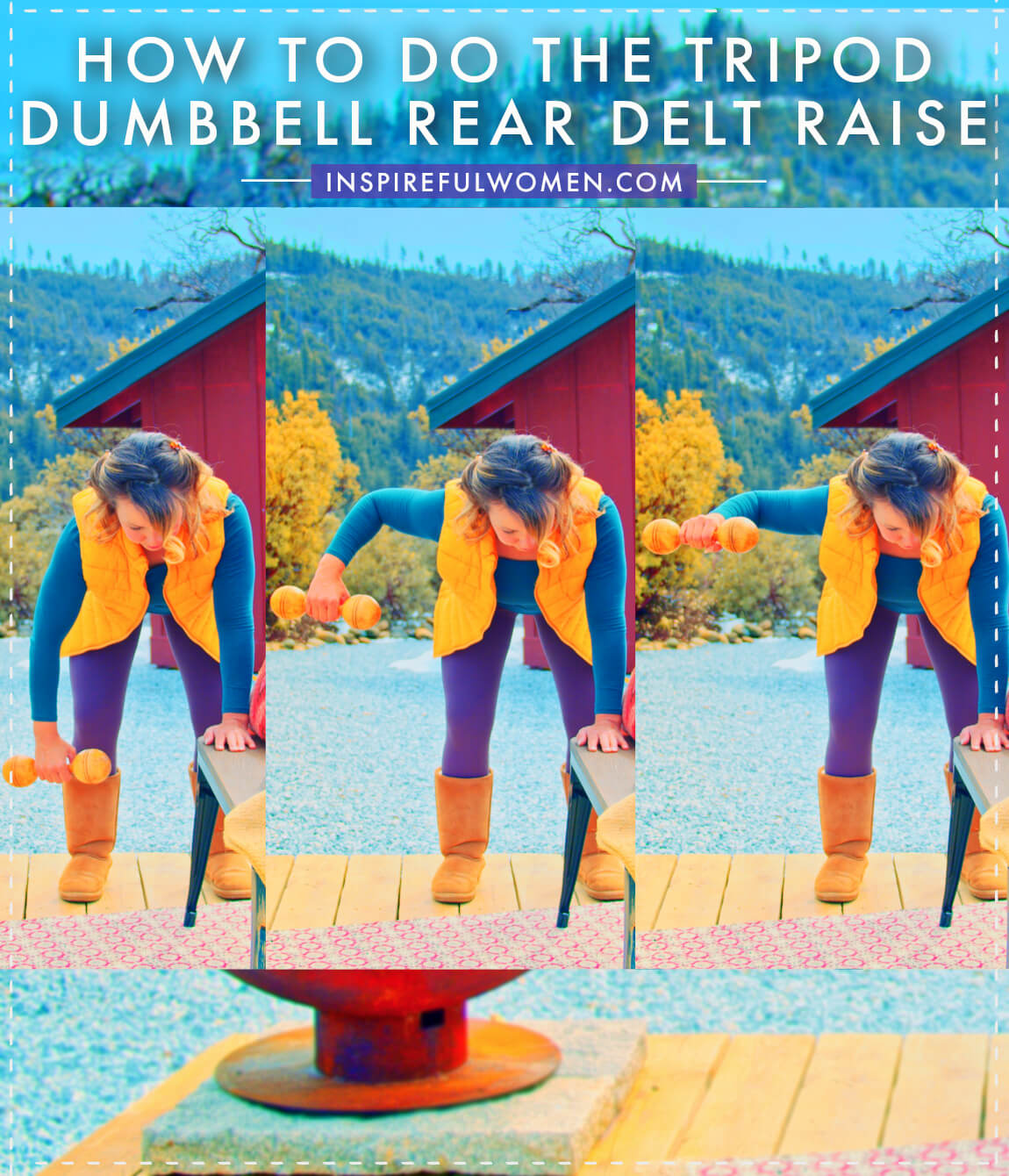
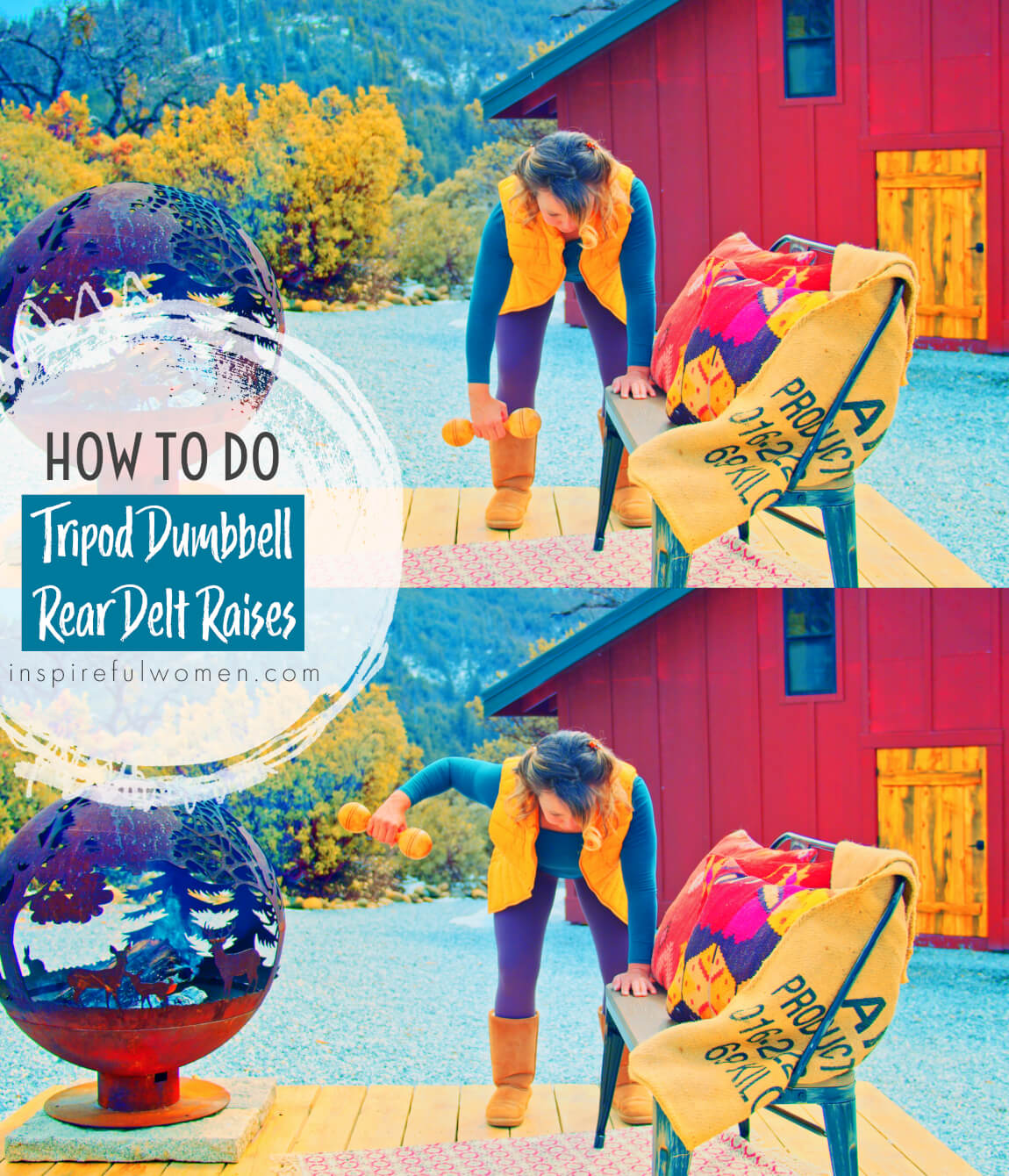
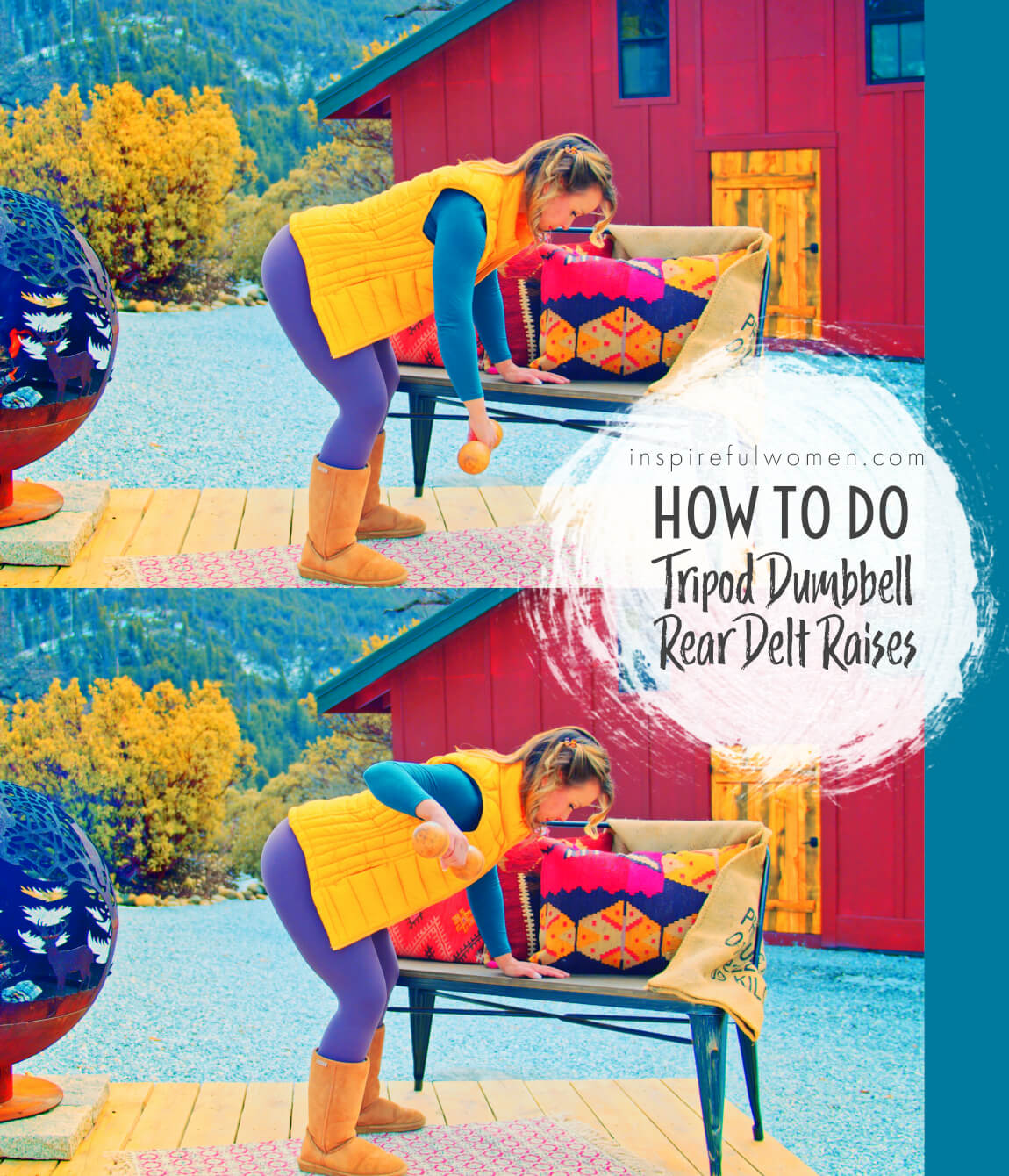
COMMON MISTAKES
COMMON MISTAKES
WHAT TO AVOID WITH Dumbbell Tripod Rear Delt Rows
KEY TIP:
Guess what? Good news! Many avoids are the same for most movements. Once you learn the basics, there's really only a few extra avoids for each individual movement.
1. Avoid elbow drop
AVOID: Avoid letting the upper arm drop down as up rotate the arm.
WHY NOT?
- This will take the tension off of the deltoid and will decrease how much the muscle is working.
WHAT TO DO:
- Keep the upper arm lifted and concentrate on rotation of the bone in the socket.
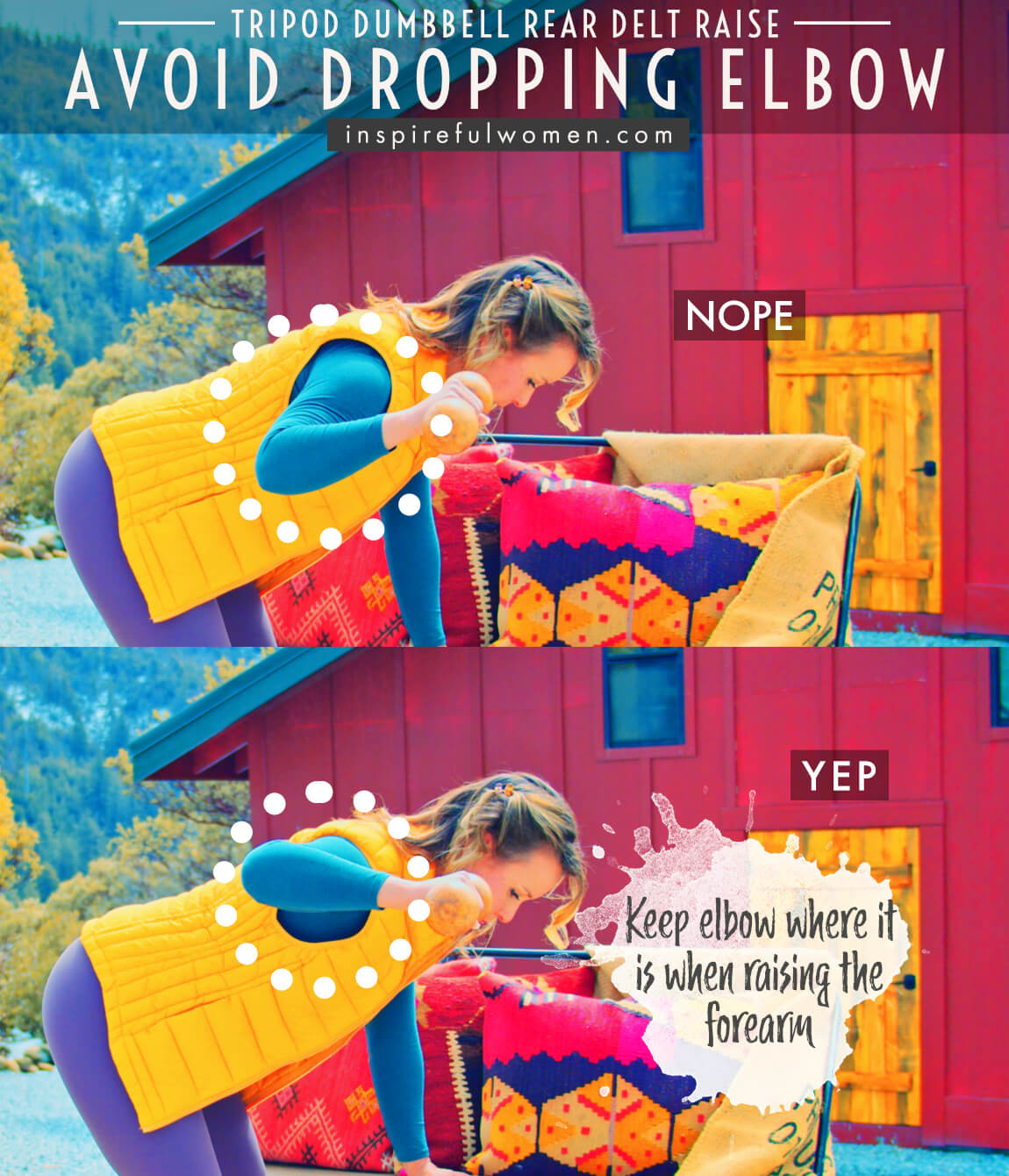
2. Avoid arching spine
AVOID: Avoid arching your low back.
WHY NOT?
- Can lead to low back joint injury, muscle strain, or damage over time.
WHAT TO DO:
- Maintain a neutral spine position.
- Troubleshooting suggested fixes
- Poor core strength: activate your abdominal muscles, or do choose a position with more support.
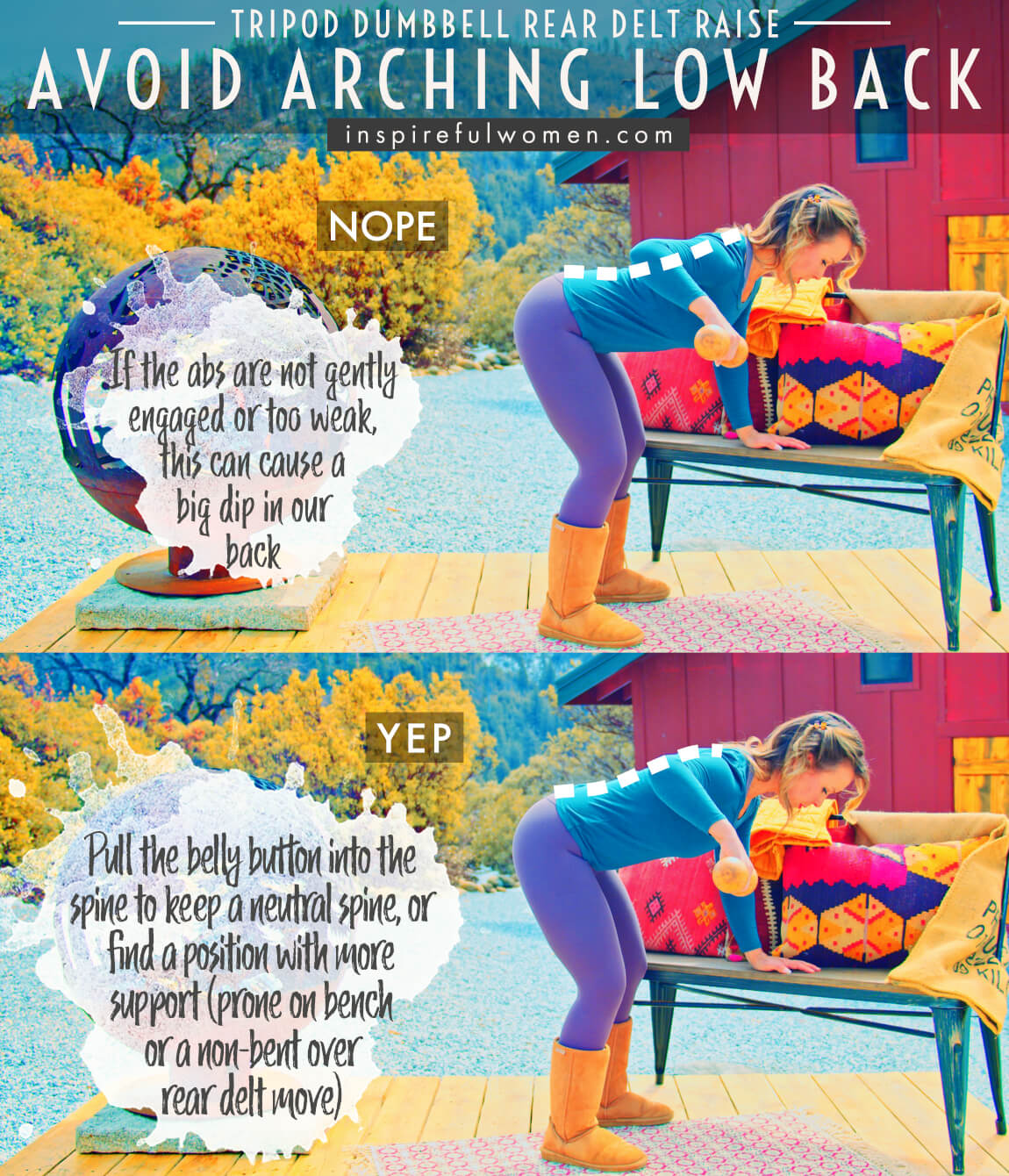
3. Avoid rounding spine
AVOID: Avoid rounding (flexing) your low back.
WHY NOT?
- Can lead to muscle strain or low back joint injury, it will also decrease the activation of the targeted muscles.
WHAT TO DO:
- Maintain a neutral spine position.
- May be caused by poor back extensor strength: choose a position with more support.
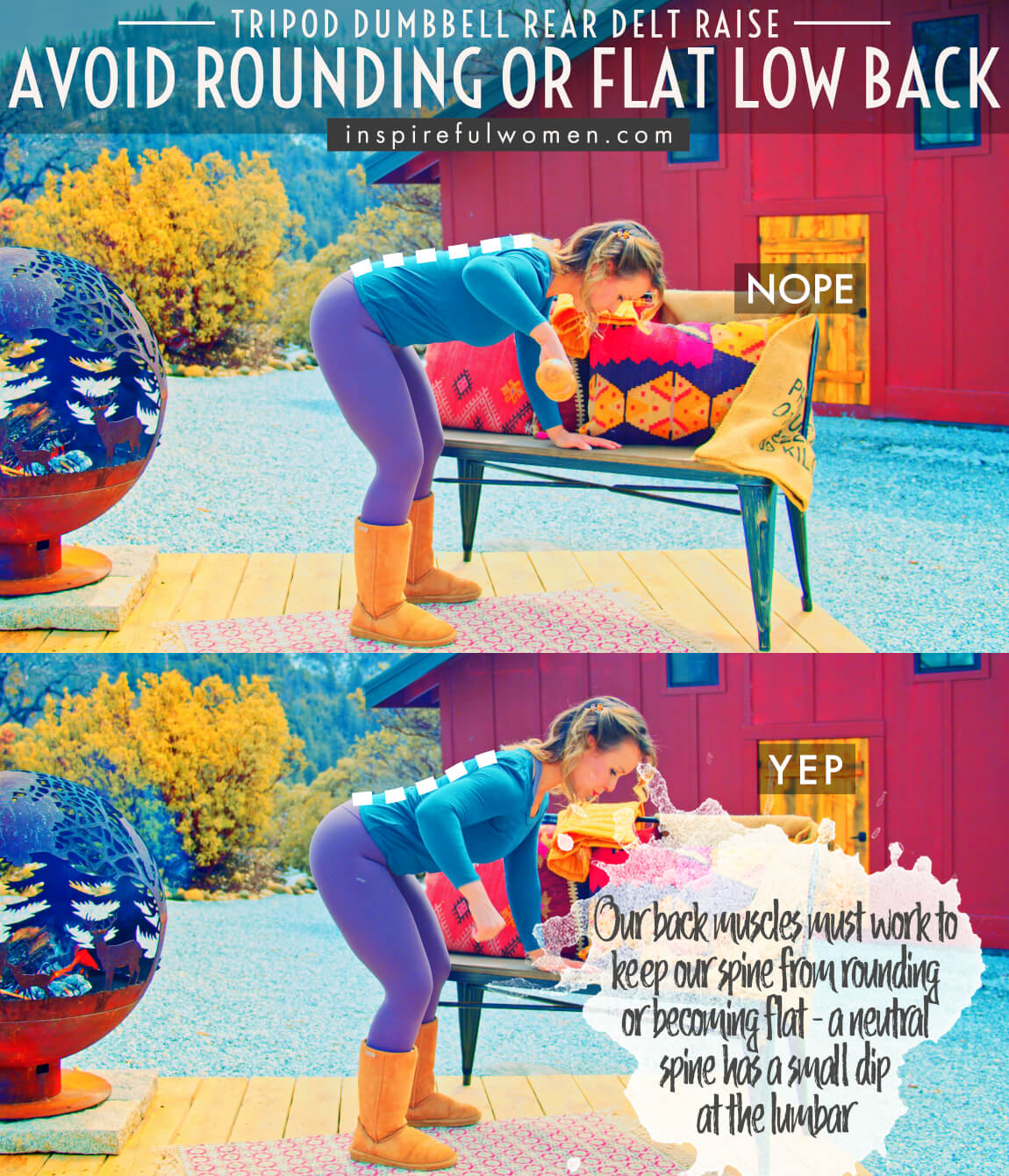
4. Avoid Bending Wrists
AVOID: Avoid moving through your wrists.
WHY NOT?
- Poor alignment (bent forward or backward) or repetitive movement through the wrist can lead to joint and/or soft tissue irritation or injury over time.
WHAT TO DO:
- Your wrists should be in line with your forearm and should be still throughout the exercise.
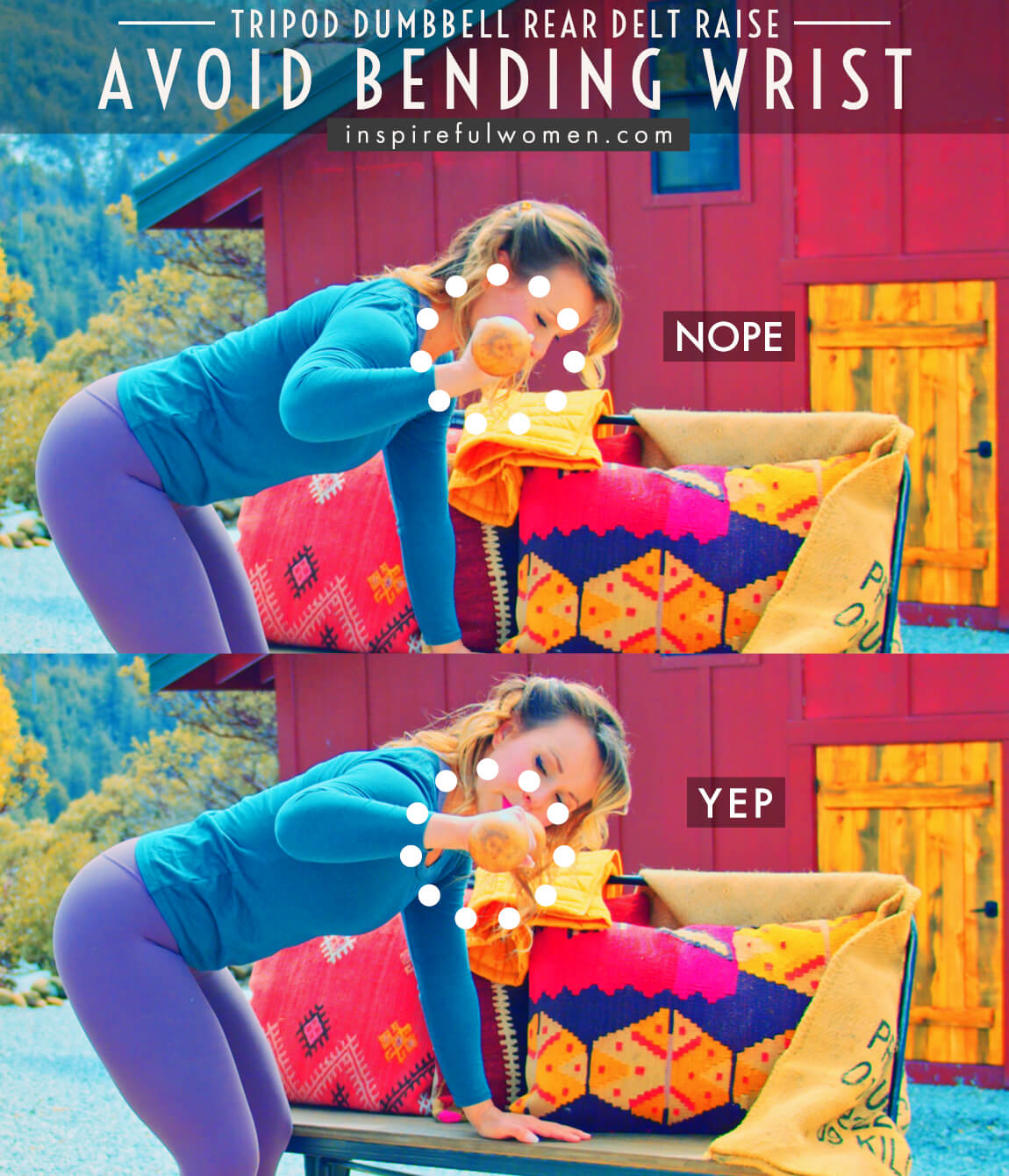
5. Avoid locking knees
AVOID: Avoid straightening or locking the knees of standing legs.
WHY NOT?
- This tends to decrease the lumbar curve, pull on the hamstrings and decrease the muscle activity of the legs.
- Locking the knees puts stress on the knee joint and can make it more difficult to maintain a neutral spine.
WHAT TO DO:
- If you feel pressure or discomfort in the low back or knees, try bending the knees.
- Keep the knees soft, with a slight bend.

6. Avoid too heavy weight
AVOID: Avoid sacrificing range of movement for increased weight.
WHY NOT?
- The deltoid will become most active towards the end of the movement when the upper arm is behind your shoulder joint and externally rotated.
- Increasing the weight may prevent you from being able to get to this position.
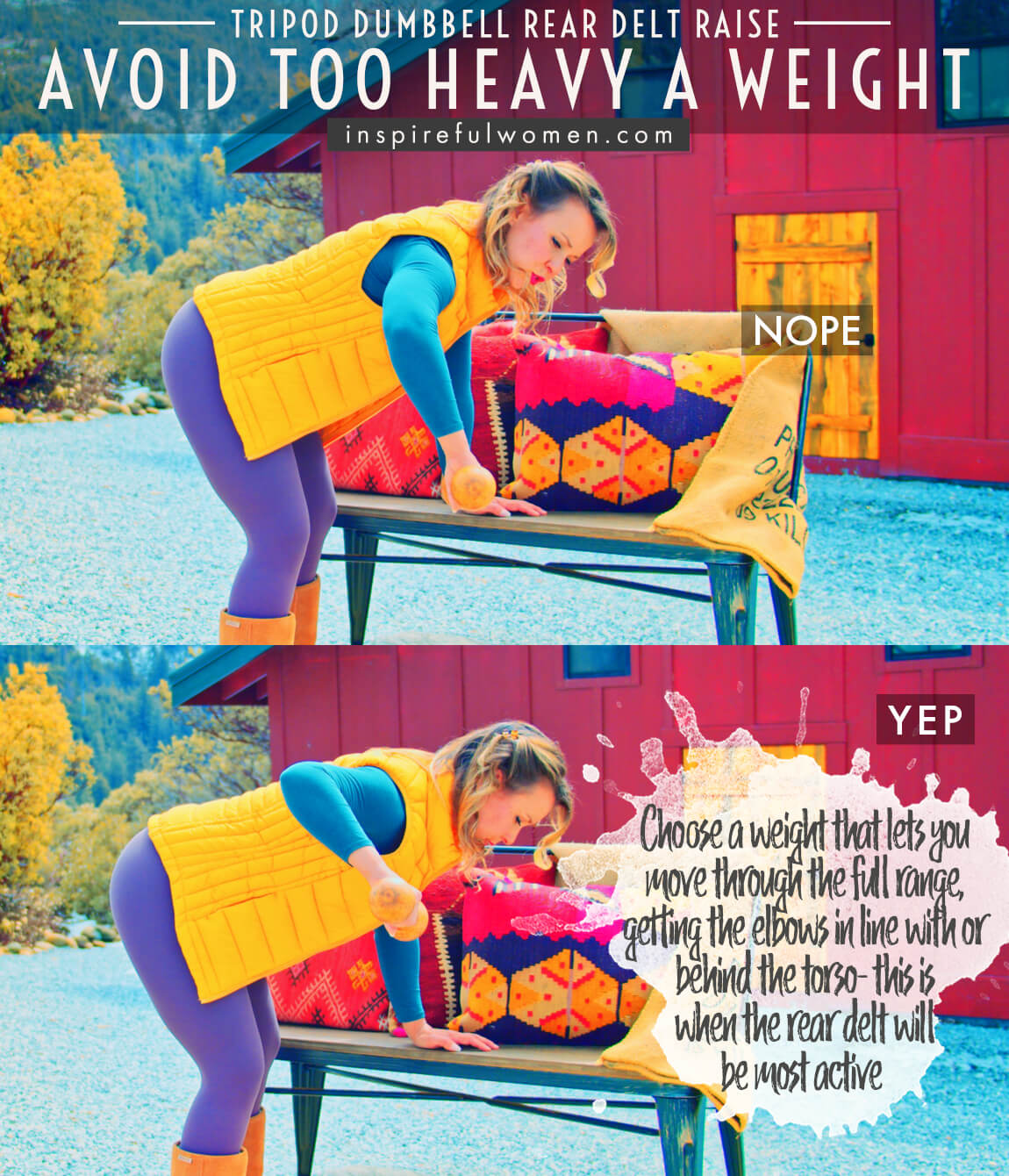
7. Avoid Rotating Torso with Arm
AVOID: Avoid rotating your upper body when you lift your arm up.
WHY NOT?
- This would indicate you are moving through your spine as opposed to through the shoulder joint.
- Repetitive spinal movement under load can cause soft tissue/joint irritation or damage over time.
WHAT TO DO:
- Don’t let your upper back drop or lift up with your arm.

8. Avoid locking elbow
AVOID: Avoid hyperextending or locking the “non-working” arm that’s supporting you on the bench.
WHY NOT?
- This puts a lot of stress on the elbow joint and can result in injury or damage over time.
WHAT TO DO:
- Try bending the support elbow a bit.
- If you tend to hyperextend your elbows, choose a position that does not involve weight bearing through the arm.
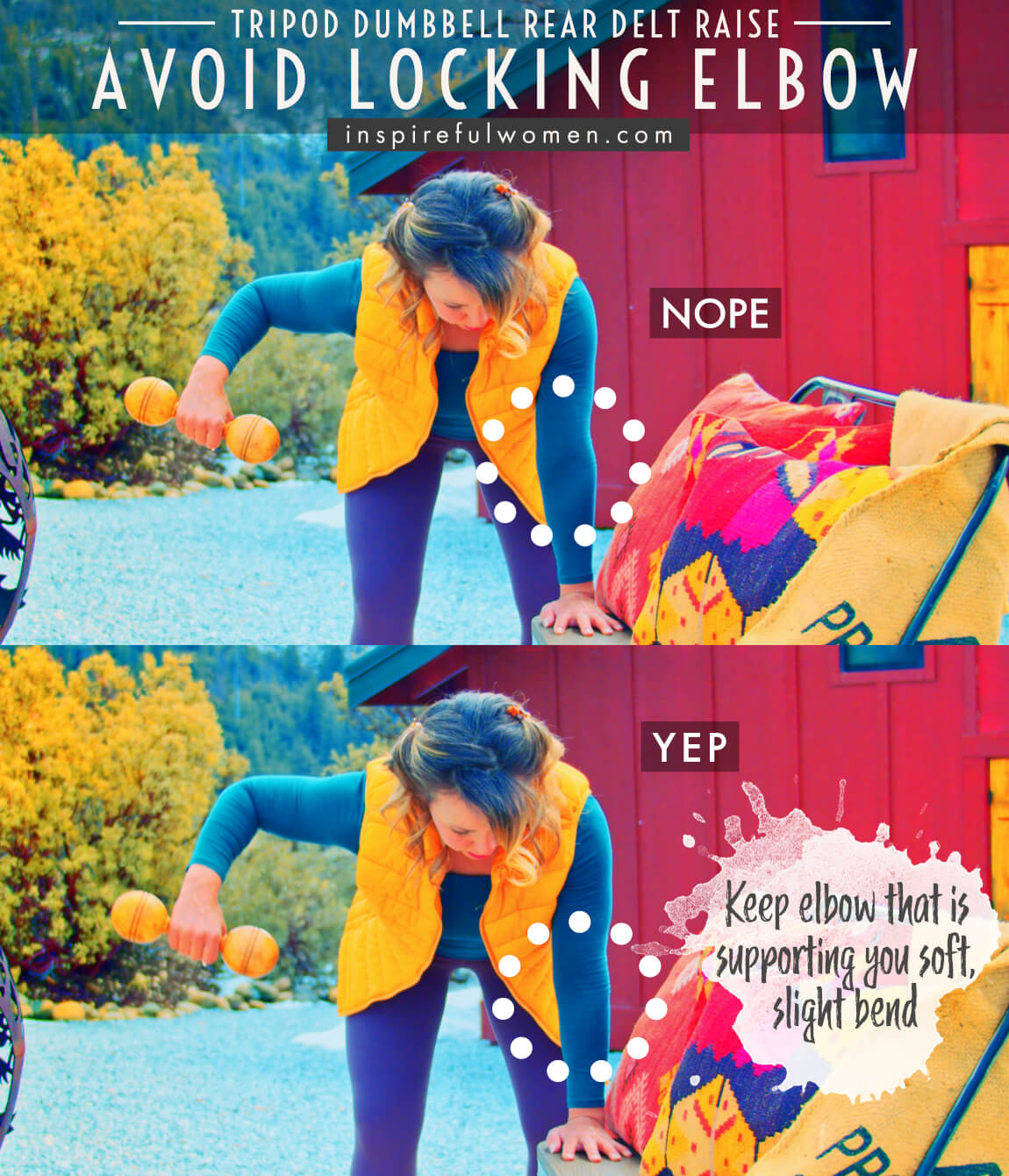
WHAT WE'RE DOING TODAY
WHAT & WHY
BENEFITS OF TRAINING THE rear deltoid
WHAT
This exercise is designed to work muscle on the back of the shoulder - the back (posterior or rear) part of the deltoid muscle. These muscles are worked by moving the arm back, and slightly behind the body. The rear deltoid also helps to rotate the arm the underside of the arm up.
This version of the rear deltoid raise is done leaning over with one hand on a stable surface. The other arm is lifted up, behind the torso, and rotated out to activate the part of the deltoid muscle that is on the back of the shoulder.
WHY BOTHER DOING IT?
WHY
WHY DO WE EVEN CARE?
WORK THE SLIGHTLY IGNORED PART OF OUR SHOULDER MUSCLE
The deltoid muscle is the large visible muscle on the top of the shoulder. The muscle can be thought of as having 3 different parts, each part moves the arm in a different direction. The rear deltoid or posterior deltoid is the part of the muscle that lies on the back side of the shoulder. The other two parts of the deltoid muscle lift the arm to the front and to the side of the body. In our everyday lives, and even in our workouts, we spend a lot of time moving our arms to the front and to the sides of the body. We spend very little time moving our arms behind us.
This might make you think that the rear deltoid does not need to be strong. But it is important to know that all three parts of the muscle need to be able to work together to keep the shoulder joint healthy. The entire deltoid muscle works to stabilize the shoulder joint when you use your arm, and when you are lifting or carrying a heavy object. A well-balanced deltoid muscle is needed for healthy shoulder movement and posture. If you strengthen the front and middle deltoids but not the rear deltoids, then you will create an imbalance. Keeping all three parts of the deltoid muscle strong and healthy can improve posture, make lifting and carrying easier, and prevent injury. The rear deltoid raise also works the muscles of the back, including the muscles around the shoulder blade that work to correct a slumped posture position.
PROMOTES MORE CONTROLLED MOVEMENT OF OUR SHOULDER
It is interesting (at least to me) to think about how the muscles work. Muscles work together to coordinate movement, so even though one muscle is primarily responsible for a specific movement - if the other muscles are not balancing out the primary mover - our movement would be very uncontrolled.
For example: throwing a ball, even though the front of the shoulder and the chest muscles are doing most of the work to pull the arm forward forcibly, the back of the shoulder needs to be putting on the brakes - just the right amount at just the right time in order to control the movement. If the muscles on the front overpower the muscles on the back of the shoulder - the upper arm bone would move forward in the shoulder joint. Over time, this can damage the joint or the soft tissues of the joint.
WORKS THE REAR DELT FOR BOTH IT'S FUNCTIONS + BONUS ROTATOR CUFF WORK!
These exercises are designed to target the rear deltoid by working it into both it's main functions:
1. extension
2. external rotation
The exercise does a good job of working the rear delt at the same time as the rotator cuff muscles (infraspinatus and teres minor) which is important for establishing good movement patterns.
This exercise is done in a bent over position. To hold the position, the muscles of the back of the legs (gastroc/soleus, hamstrings and gluteus maximus) need to be active. The back extensor muscles will work to hold the torso against the downward pull of gravity. The resistance is pulled back (as opposed to pulled down or up at an angle) so the scapular muscles, especially the mid and lower traps, rhomboids, and serratus anterior will help with the movement.
LOOKS LIKE THE BOMB.COM
I think defined rear delts just look awesome on a woman! I'm not usually into trying to look all a certain way, but there's something super attractive to me about having nice shape in this area.
EVERYDAY LIFE
EVERYDAY LIFE &
MUSCLE FUNCTION
HOW WE USE OUR rear deltoid MUSCLES IN EVERYDAY LIFE
1. REACHING BEHIND THE BODY
- Tending a kid in the back seat
- Reaching into the back pocket
- Bringing the arm back to throw a ball (overhand)
2. PULLING
- Pulling a car door shut
- Pulling a refrigerator door open
3. ROTATING THE ARM UP (EXTERNAL ROTATION)
- Reaching the back of your head for washing, brushing your hair
- Pulling a shirt off over your head
- Reaching the top of a zipper
- Scratching your upper back
- Turning your outstretched arm with the palm up (need shoulder external rotation and forearm supination)
- Receiving change in the palm of the hand
4. WORKS WITH THE OTHER PARTS OF THE DELTOID MUSCLE (ANTERIOR, MIDDLE FIBERS OF THE DELTOID) TO STABILIZE THE SHOULDER JOINT
- Improves the ability to lift and carry heavy objects (the arm has a stable base to work off of).
- Injury prevention
HOW TO FEEL WHAT MUSCLE IS WORKING
How to Feel What Muscle is Working
Take your opposite hand and place it on top of your shoulder. You should feel a hard, flat surface right on top close to the shoulder joint. Drop your fingers right below the bony surface. Hold your upper arm up (approximately 50 - 60 degrees out to the side) with the elbow bent. Push the upper arm back. You should feel the rear fibers of the deltoid activate under your fingers. It can help to push your elbow into the back of the chair or a wall.
SCIENCY STUFF
ALLLL MUSCLES & WHEN
ALL MUSCLES WORKING & WHEN DURING THE Dumbbell Tripod Rear Delt Raise
The muscles of the supporting (nonworking arm and legs) are active isometrically to hold the bent-over position. The middle and lower traps, rhomboids, serratus anterior work to stabilize the shoulder blades in towards the spine (retraction) and down the back (depression) so that the arm muscles have a stable base to work off of.
The beginning of the movement (bottom) is initiated by the posterior deltoid and triceps.
As the arm is lifted backwards and the elbow bends the deltoid will kick in more and the triceps will become less involved. The scapular retractors pull the shoulder blades together to help with extension of the shoulder.
The obliques and quadratus lumborum will be slightly more active as the arm is lifted to prevent any rotation of the spine.
The arm is extended back and the rear deltoid, infraspinatus and teres minor contract concentrically to externally rotate the arm.
The arm is lowered back to the starting position through eccentric contraction of the posterior deltoid.
PIN IT FOR LATER!


